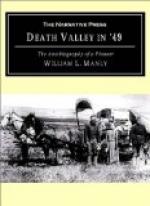We helped them in crossing the river, which was somewhat difficult, being swift, with boulders in the bottom but we got all safely over and then made the trade we had spoken of. Dallas paid me for my pony and we took what flour and bacon he would let go. He gave us some ropes for head and stern lines to our boat and a couple of axes, and we laid these, and our provisions in a pile by the roadside. Six of us then gave up our whips. Mr. S. McMahon, a driver, hesitated for some time, but being pressed by Dallas for a decision, at last threw down his whip and said:—“I will go with the boys.” This left Dallas with only one driver, but he took a whip himself, and with the aid of the children and his wife who drove the two-horse wagon, they got along very well. I paid for such provisions as we had taken, as the rest of the fellows had almost no money.
So we parted company, the little train slowly moving on its way westward. Our military captain, the soldier boys, and the gay young lady taking the route to Oregon, and we sitting on the bank of the river whose waters flowed to the great Pacific. Each company wished the other good luck, we took a few long breaths and then set to work in earnest to carry out our plans.
CHAPTER VIII.
About the first thing we did was to organize and select a captain, and, very much against my wishes, I was chosen to this important position. Six of us had guns of some sort, Richard Field, Dallas’s cook, was not armed at all. We had one regular axe and a large camp hatchet, which was about the same as an axe, and several very small hatchets owned by the men. All our worldly goods were piled up on the bank, and we were alone.
An examination of the old ferry boat showed it to be in pretty good condition, the sand with which it had been filled keeping it very perfectly. We found two oars in the sand under the boat, and looked up some poles to assist us in navigation. Our cordage was rather scant but the best we could get and all we could muster. The boat was about twelve feet long and six or seven feet wide, not a very well proportioned craft, but having the ability to carry a pretty good load. We swung it up to the bank and loaded up our goods and then ourselves. It was not a heavy load for the craft, and it looked as if we were taking the most sensible way to get to the Pacific, and almost wondered that everybody was so blind as not to see it as we did.
This party was composed of W.L. Manley, M.S. McMahon, Charles and Joseph Hazelrig, Richard Field, Alfred Walton and John Rogers. We untied the ropes, gave the boat a push and commenced to move down the river with ease and comfort, feeling much happier than we would had we been going toward Salt Lake with the prospect of wintering there.
At the mouth of Ham’s Fork we passed a camp of Indians, but we kept close to the opposite shore to avoid being boarded by them. They beckoned very urgently for us to come ashore, but I acted as if I did not understand them, and gave them the go-by.




